What Is an Ecosystem's Productivity?

An ecosystem’s productivity is a central ecological concept used for understanding the variety and differences among the Earth’s environments. This parameter is the fundamental basis for the functioning of ecological networks.
So, what are the foundations of an ecosystem’s productivity? What types are there? In the following article, we’ll answer these questions about its functioning and foundations.
An ecosystem’s productivity
Animals and plants use the energy they get from their food to fulfill their vital functions. Likewise, that energy will be used for the growth of the living being. Growth, from a functional point of view, is nothing more than an increase in biomass —energy stored in the form of matter in living beings.
This increment of biomass is an efficient way of determining the dynamics of ecosystems, and can be measured in different ways.
In ecology, productivity is the increase of biomass per unit surface per unit of time. However, beyond this simple definition lies a measurable parameter that influences the vast complexity of the ecological systems present on Earth.
Productivity, therefore, measures the change in the amount of living beings at a given time and place. There are various types of productivity that we’ll comment on in the next sections.

Primary productivity: the energy gateway
Sometimes, we humans forget the importance of plants for life. Due to their way of feeding, plant organisms are considered primary producers: the gateway of energy into the ecosystems.
Certainly, plants make their own food based on photosynthesis. Through a series of complex biochemical reactions, plants synthesize sugars from organic and inorganic matter, which help the growth of their biomass.
In plants, the increase in biomass per unit of time and unit surface is known as primary productivity. This primary productivity is crucial for the dynamics of ecosystems, because plants are the “gateway” of the Sun’s energy into the food web.
Thus, we can distinguish between gross primary production — the simple increase of biomass — and net primary production —the increase of biomass by subtracting the energy spent on respiration. Generally, the net value is the most useful one.
Central importance of primary productivity
Primary productivity is the factor that determines the structure of food chains, that is, the food and ethological relationships between living beings within the ecosystems.
This is because plants are the basis of food for herbivores, herbivores for carnivores and so on, until they reach the super predators. Therefore, the production of biomass in plants will eventually affect all the elements of the food web.
For example, we can think of a pasture land ecosystem. If, in any given year, there is productivity in pastureland — due to lack of rain, for example — hares (herbivores) will have less food and their population will decrease. This, in turn, will affect wolves (predators), as there will be fewer herbivores available to hunt.
Ecosystems with very high productivity
Among the diverse ecosystems on our planet, productivity varies greatly. There are very productive environments, where the animal biomass grows enormously year after year. Among the ecosystems with the highest productivity, we can highlight the following:
- Wetlands
- Coral reefs
- Estuaries
- Coastal areas
- Equatorial forests
All these areas have in common very high primary productivity, which in turn binds a huge community of consumers —herbivores and carnivores. Obviously, these types of ecosystems, apart from being very productive, support an enormous biodiversity.
Ecosystems with low productivity
In contrast, in other ecosystems, primary producers (photosynthetic ones) are extremely rare, thus greatly limiting the ecosystem’s productivity. Such is the case of deserts, polar areas, and central areas of the oceans. Obviously, the absence of primary producers totally limits the presence of consumers.
Secondary productivity
Secondary productivity refers to the growth of consumer biomass per area and year. As we’ve already mentioned, these are limited by primary producers.
There’s also a huge limitation on secondary producers due to low processing efficiency. Animals are only able to transform about 10% of the energy contained in plants. In the case of predators, only 1% ends up transformed into pure biomass.
The more energy an animal spends in its metabolic processes, the less biomass it generates.

In conclusion, an ecosystem’s productivity is a parameter that provides us with important information on the dynamics of the ecosystem, and greatly influences the food network of animals and plants.
All cited sources were thoroughly reviewed by our team to ensure their quality, reliability, currency, and validity. The bibliography of this article was considered reliable and of academic or scientific accuracy.
- Granados-Sánchez, D., Ruíz-Puga, P., & Barrera-Escorcia, H. (2008). Ecología de la herbivoría. Revista Chapingo. Serie ciencias forestales y del ambiente, 14(1), 51-63.
- Mitsch, W. J., & Reeder, B. C. (1991). Modelling nutrient retention of a freshwater coastal wetland: estimating the roles of primary productivity, sedimentation, resuspension and hydrology. Ecological Modelling, 54(3-4), 151-187.
- Encyclopedia Britannica (2020) Efficiency of solar energy utilization. Recuperado el 7 de mayo de 2022, disponible en: https://www.britannica.com/science/biosphere/Efficiency-of-solar-energy-utilization
